Exhibition dates: 26th November 2022 – 13th March 2023
Curator: Anthony Fitzpatrick
Peter Booth (Australian born England, b. 1940, Australia from 1958)
Painting
1978
Oil on canvas
© Peter Booth
Anima
tongue, long flickering tongue
drenched in blood
scours inside the cup
rapacious for more
blood thirsty luck
sucks souls of men
thorn and star
spirit of insect
bizarre–unique
cannibal
Dr Marcus Bunyan
Many thankx to the TarraWarra Museum of Art for allowing me to publish the media images in the posting. All other installation photographs as noted © Marcus Bunyan, the artist and TarraWarra Museum of Art. Please click on the photographs for a larger version of the image.
“A lot of humans forget we are organic entities, the same as every other creature on the planet, and we’ve only been here for a short time. I am very pessimistic about the plight of beings. We don’t learn much, I mean, we’ve been wreaking havoc as they did in the Middle Ages. We also have bigger weapons. One thing I am not pessimistic about is the ability of nature to heal itself.”
Peter Booth quoted in Ashley Crawford View from the Booth blog 29 November 2003
PETER BOOTH at TarraWarra Museum of Art
Introductory wall text from the exhibition
Installation view of the exhibition Peter Booth at TarraWarra Museum of Art showing at left Painting 1974, and at centre Painting 1975 1975
Photo: Marcus Bunyan
While the TarraWarra survey features a collection of Booth’s works from the 1970s to the 2000s, it opens with a work in the ‘Doorway’ series: Painting, 1974. It’s a canvas covered with shades of black. As the curator says, “Just near the top, there’s this very thin horizon line of red, and it feels like there’s this massive magma just behind the surface that’s starting to seep through.” I’m told that written on the back of some ‘Doorway’ paintings is an instruction: “Never hang more than six inches from the floor.” As Fitzpatrick explains, “If you hang the work a little lower for the viewer … it becomes more immersive, and this painting is the opening work in the exhibition with the idea of the doorway as a threshold.”
This minimalism is compelling. “The ‘Doorway’ series could be about nothingness, or it could be a void,” says Fitzpatrick, “but voids are also where things are generated from – so they could be about an idea of fullness … you could almost see them as a kind of dark mirror.” In a rare interview with Australian artist, writer and curator Peter Hill, Booth humbly discusses how the ‘Doorway’ series was “influenced by what was going on in the art world at the time, in reduction, minimalism and colour field painting”.
Autumn Royal. “Once seen, Peter Booth is never forgotten,” on the Art Guide website 15 January 2023 [Online] Cited 02/02/2023
Peter Booth (Australian born England, b. 1940, Australia from 1958)
Painting
1974
Synthetic polymer paint on canvas
213 x 167.5cm
Queensland Art Gallery, Gallery of Modern Art, Brisbane
Purchased 2006 with funds from the Estate of Lawrence F. King in memory of the late Mr and Mrs S.W. King through the Queensland Art Gallery Foundation. Photograph: Natasha Harth, QAGOMA
© Peter Booth
Peter Booth (Australian born England, b. 1940, Australia from 1958)
Painting 1975
1975
Synthetic polymer paint and glass on canvas
274.2 x 167.2cm
TarraWarra Museum of Art collection
Gift of Eva Besen and Marc Besen AO, 2001
© Peter Booth
Peter Booth (Australian born England, b. 1940, Australia from 1958)
Painting (installation view)
1977
Oil on canvas
Museum of Old and New Art (Mona), Hobart
© Peter Booth
Photo: Marcus Bunyan
With its shrouded figure standing before a highly volatile and fiery landscape, Painting 1977 conveys a forceful and undeniably apocalyptic vision. The painting finds a literary counterpart in the work of one of Booth’s favourite writers at the time, the novelist Doris Lessing with whom he found an affinity in their shared dystopian outlook. With its powerful blend of fantasy and reality, her 1971 novel Briefing for a Descent into Hell recounts the tale, vividly narrated in the first person, of a psychiatric patient’s hallucinatory journey through a dangerous and disturbing world of environmental despoliation, societal collapse, violent conflict and cosmic cataclysm.
Wall text from the exhibition
Doris Lessing (British-Zimbabwean born Iran, 1919-2013)
Briefing for a Descent into Hell
1971
Vintage book cover published 1981
Peter Booth (Australian born England, b. 1940, Australia from 1958)
Untitled (Daughters)
c. 1976
Ink on paper
11 x 12.5cm
Private collection
Untitled (Daughters), c. 1976, is a composition which originated in Booth’s visits to an inner-city park in Melbourne where he would take his young daughters to play. Here, through the intense rhythms of his lifework and cross hatching in black ink, and the introduction of symbolic forms such as a whirlpool and arrowhead, this everyday scene is imaginatively transformed into a mysterious, nocturnal realm. While his daughters play in the foreground, the artist has turned to face a rising moon on the horizon and there is a sense that he is being magnetically compelled to embark on the path which leads in its direction.
Text from the TarraWarra Museum of Art Facebook page
Installation view of the exhibition Peter Booth at TarraWarra Museum of Art showing at centre, Painting 1978
Photo: Marcus Bunyan
Installation view of Peter Booth Painting 1978 from the exhibition Peter Booth at TarraWarra Museum of Art
Photo: Marcus Bunyan
Peter Booth became known for his black, minimal ‘doorway’ paintings of 1970-74. Yet by 1977 he had given up this style and begun to record the world of his dreams and nightmares in a series of apocalyptic, visionary landscapes. Booth’s paintings suggest that we are on the edge of another dark age. His paintings are brutal representations of his bleak dreams and fantasies. In an age of nuclear threat Booth’s work has a monumentality which is evocative of the final conflagration mentioned in The Book of Revelations. Painting 1978, challenges and disturbs the viewer by the artist’s choice of colour and method of painting. The dramatic black and red, yellow and white composition suggests both an industrial and a natural wasteland. The heavy impasto paint texture describes, with vigour and intensity, flames, explosions, and unidentified nightmarish images. Contradictory forces pull us into the central inferno below the glacial mountain peaks, and showers of rock explode towards us. Is it the artist himself who stands with his back to us, mesmerised by the scene, while grotesque metamorphosing figures stare out at us?
Text © National Gallery of Australia, Canberra
Booth’s subject matter largely concerns the Australian landscape, both urban and rural, and the relationship between environment and individual, as well as the individual’s capacity to create and destroy. And also what the world will be like in the future, humans as mutants.
Booth’s landscapes are charged with emotion and symbolic meaning. Memories of his childhood in the blackened industrial landscape of Sheffield seem to infuse the work, especially his well-known apocalyptic figurative paintings, which look like images of the end of the world; illustrations for The Book of Revelation. These images contain an intense image of anxiety, evoking the aftermath of some terrible destruction, vividly pictured with menacing forms and agitated, heavily applied brushstrokes.
An example is Painting 1978 which has been described as challenging and disturbing the viewer by the artist’s choice of colour and method of painting. “The dramatic black and red, yellow and white composition suggests both an industrial and a natural wasteland”. The heavy impasto paint texture describes, with vigour and intensity, flames, explosions, and unidentified nightmarish images. Contradictory forces pull us into the central inferno below the glacial mountain peaks, and showers of rock explode towards us.
Is it the artist himself who stands with his back to us, mesmerised by the scene, while grotesque metamorphosing figures stare out at us?” Peter Booth has centred many of his paintings around his childhood in Sheffield England where he grew up during the war years and their aftermath.
Anonymous. “Peter Booth,” on the Art History Essay website Nd [Online] Cited 07/02/2023
Peter Booth (Australian born England, b. 1940, Australia from 1958)
Drawing (Figure with Insect Tail)
1982
Pastel and casein on paper
17.3 x 12.5cm
National Gallery of Victoria, Melbourne
Purchase, Victorian Foundation of Living Australian Artists, 2010
More than just figures of fantasy, Booth’s curious amalgams and mutated figures often express his personal insights into the interrelatedness of all living beings. With his closed eyes and restful expression, the metamorphic figure in Drawing (Figure with Insect Tail) appears contented with his hybrid condition, affirming the artist’s belief that humans “share something with these creatures … we are part of the same thing.”
Text from the TarraWarra Museum of Art Facebook page
William Blake (British, 1757-1827)
The Ghost of a Flea
c. 1819
Tempera heightened with gold on mahogany
214 x 162 mm
Tate
Bequeathed by W. Graham Robertson 1949
Another physiognomic “vision” – “the stuff of delirium and nightmare, [which] taps into the unconscious, internalised sublime” – was the painting The Ghost of a Flea (c. 1819) used to illustrate John Varley’s Treatise on Zodiacal Physiognomy (1828). In studying the work of Blake for this posting, I found it instructive to look at Blake’s preparatory sketches for his works which can be found online. They give you a good idea of the spontaneity of the drawing and the ideas that arise, transformed into the finished work. Here in the graphite on paper drawing of The Ghost of a Flea we can see Blake’s initial vision, a more static, pensive figure with serrated wings which morphs into a muscular, blood sucking monster set on a cosmic stage, of life framed by curtains and a shooting star. As the vision appeared to Blake he is said to have cried out: ‘There he comes! his eager tongue whisking out of his mouth, a cup in his hand to hold blood, and covered with a scaly skin of gold and green.’
Marcus Bunyan. “Visions of divine damnation” on the exhibition William Blake at Tate Britain, London Part 2, February 2020 on the Art Blart website [Online] Cited 09/02/2023
William Blake (British, 1757-1827)
The Ghost of a Flea
c. 1819
Graphite on paper
Private collection
Photo: © Marcus Bunyan and Tate
Artist and astrologer John Varley encouraged Blake to sketch the figures, called ‘visionary heads’, who populated his visions. This image is the best known. While sketching the flea, Blake claimed it told him that fleas were inhabited by the souls of bloodthirsty men, confined to the bodies of insects because, if they were the size of horses, they would literally drain the population. Their bloodthirsty nature is shown by the eager tongue flicking at the ‘blood’ cup it carries. This intense disorientating image, the stuff of delirium and nightmare, taps into the unconscious, internalised sublime.
William Blake, “The Ghost of a Flea c. 1819-20,” in Nigel Llewellyn and Christine Riding (eds.), The Art of the Sublime, Tate Research Publication, January 2013
Wall text from the exhibition
Installation view of the exhibition Peter Booth at TarraWarra Museum of Art showing from left to right, Painting Two 1984, Painting 1984 and Leadman 1986
Photo: Marcus Bunyan
Peter Booth (Australian born England, b. 1940, Australia from 1958)
Painting Two
1984
Oil on canvas
198 x 305cm
National Gallery of Victoria, Melbourne
Purchased 1985
© Peter Booth
In the blasted landscape of Painting Two we are presented with a vision of a volatile world in the process of unnatural mutation. As an artist who has always been keenly attuned to what’s happening environmentally and politically, this painting forcefully conveys the fallout of a colossal act of destruction, reflecting widespread concerns in the 1980s over the dramatic escalation of the nuclear arms race between the United States and the Soviet Union and the threat of atomic warfare.
Wall text from the exhibition
Peter Booth (Australian born England, b. 1940, Australia from 1958)
Painting (installation view)
1984
Oil on canvas
© Peter Booth
Photo: Marcus Bunyan
Peter Booth (Australian born England, b. 1940, Australia from 1958)
Leadman (installation view)
1986
Oil on canvas
TarraWarra Museum of Art collection
Gift of Eva Besen and Marc Besen AO 2001
© Peter Booth
Photo: Marcus Bunyan
In this work a hulking grey figure, with his fierce determination and body braced for battle, appears to be biologically adapted for survival in a desolated terrain. As the title suggests, this unrelentingly bleak and polluted atmosphere has eventuated from the unbridled destructive ambitions of the toxic Leadman who has transformed the world in his own image.
Wall text from the exhibition
Installation view of the exhibition Peter Booth at TarraWarra Museum of Art showing from left to right, Leadman 1986, Painting 1984 and Painting 2012
Photos: Marcus Bunyan
Peter Booth (Australian, b. 1940)
Painting
1984
Oil on canvas
101 x 183cm
Heide Museum of Modern Art
The Baillieu Myer Collection of the ’80s
© Peter Booth
Peter Booth (Australian, b. 1940)
Painting
2012
Oil on canvas
213.5 x 91cm
National Gallery of Australia, Canberra
© Peter Booth
William Blake (English, 1757-1827)
Thenot Remonstrates with Colinet
Thenot Under a Fruit Tree
Thenot Remonstrates with Colinet, Lightfoot in the Distance
Colinet Departs in Sorrow, a Thunder-Scarred Tree on the Right
Blasted Tree and Blighted Crops
The Good Shepherd Chases Away the Wolf
Sabrina’s Silvery Flood
Colinet’s Fond Desire Strange Lands to Know
1821
From The Pastorals of Virgil adapted by R.J. Thornton, 3rd edition. F.C. & J. Rivington et al., London 1921
Wood engravings on thin, white handmade wove paper
National Gallery of Victoria, Melbourne
Purchased 1960
Photo: Marcus Bunyan
William Blake (English, 1757-1827)
Blasted tree and blighted crops
1821
From The Pastorals of Virgil adapted by R.J. Thornton, 3rd edition. F.C. & J. Rivington et al., London 1921
Wood engraving on thin, white handmade wove paper
National Gallery of Victoria, Melbourne
Purchased 1960
William Blake (English, 1757-1827)
The Good Shepherd Chases Away the Wolf
1821
From The Pastorals of Virgil adapted by R.J. Thornton, 3rd edition. F.C. & J. Rivington et al., London 1921
Wood engraving on thin, white handmade wove paper
National Gallery of Victoria, Melbourne
Purchased 1960
William Blake (English, 1757-1827)
Colinet’s Fond Desire Strange Lands to Know
1821
From The Pastorals of Virgil adapted by R.J. Thornton, 3rd edition. F.C. & J. Rivington et al., London 1921
Wood engraving on thin, white handmade wove paper
National Gallery of Victoria, Melbourne
Purchased 1960
Cabinet text from the exhibition
Photo: Marcus Bunyan
A survey exhibition of the work of the renowned Australian artist Peter Booth
With a remarkable career spanning several decades, Melbourne-based Booth is a unique voice in Australian art. This new survey of paintings and works on paper is the first major public gallery exhibition of Peter Booth’s work since the NGV retrospective in 2003 and features a number of the artist’s most significant works from the 1970s to 1990s, alongside important recent works from the past two decades.
The exhibition is presented thematically, honing in on and highlighting particular motifs, subjects and moods which have become hallmarks of Booth’s expansive oeuvre: stillness and turbulence, alterity and alienation, mutation and hybridity, the absurd and the grotesque, the road and the ruin, and the despoliation and the resilience of nature.
A small group of abstract paintings from the mid-1970s at the start of the exhibition provide a prelude to an important series of gestural paintings which mark the beginning of the artist’s journey into the highly expressive landscape and figure subjects which have characterised his practice since that time.
The exhibition progresses through Booth’s vivid imaginings of an apocalyptic world characterised by grotesque, unsettling, and at times absurd scenes of human and hybrid figures in varying states of apprehension, aggression and conflict. These works will be accompanied by a small selection of prints by William Blake, James Ensor, Francisco Goya, and Samuel Palmer, visionary artists who have been important touchstones for Booth and with whom he shares a number of affinities.
This survey also brings together important works from the past three decades to convey humanity’s often fraught and ambiguous relationship to the natural world, revealing Booth’s extraordinary capacity to transmute his intensely personal perceptions of the mysteries and forces of nature and the folly and hubris of human endeavours, into exceptional and deeply compelling paintings and drawings.
PETER BOOTH, curated by Anthony Fitzpatrick, is generously supported by The Balnaves Foundation.
Text from the TarraWarra Museum of Art website
Installation view of the exhibition Peter Booth at TarraWarra Museum of Art showing from left to right, Untitled 1997, Painting 1982 and Painting 1981
Photo: Marcus Bunyan
Peter Booth (Australian, b. 1940)
Untitled
1997
Oil on canvas
The University of Melbourne Art Collection, Michael Buxton Collection
Donated through the Australia Government’s Cultural Gifts Program by Michael and Janet Buxton 2018
© Peter Booth
In Doris Lessing’s 1974 novel, The Memoirs of a Survivor, in the aftermath of an unspecified disaster, civilisation gradually disintegrates into anarchy as hordes of people form ad hoc tribes in the city streets to increase their chances of survival. In this dystopian narrative, Lessing describes the irrational and aggressive behaviour that can be unleashed within the safety and obscurity of a large group. This same sense of apprehension is one that Booth shares in many of his depictions of crowds. In Untitled, 1997, a large throng of men forms a single, impenetrable wall, gathered together to cheer on the spectacle of a violent struggle. Disturbing and absurd in equal measure, this work graphically portrays the violent actions that can be incited by a mob.
Wall text from the exhibition
Doris Lessing (British-Zimbabwean born Iran, 1919-2013)
The Memoirs of a Survivor
1974
Penguin Random House book cover published 1988
Peter Booth (Australian, b. 1940)
Untitled (installation view detail)
1997
Oil on canvas
The University of Melbourne Art Collection, Michael Buxton Collection
Donated through the Australia Government’s Cultural Gifts Program by Michael and Janet Buxton 2018
© Peter Booth
Photo: Marcus Bunyan
Peter Booth (Australian, b. 1940)
Painting 1982 (installation view)
1982
Oil on canvas
Art Gallery of South Australia, Adelaide
A.M. Ragless Bequest Fund
© Peter Booth
Photo: Marcus Bunyan
Another scene of demonic possession enacted under the spell of a fiendish presence, Painting 1982, confronts the viewer with a deeply disturbing vision of human cannibalism. With its visceral imagery of mutilation and dismemberment, parallels have been drawn to the atrocities depicted in Goya’s series of etchings The Disasters of War, 1810-1815, while the highly theatrical quality of the painting suggests a more recent connection to George A. Romero’s cult zombie film Night of the Living Dead, 1968. When the work was first exhibited critics responded to what the painting conveyed about the current state of western mass culture, finding in its brutal imagery a powerful metaphor for greed and material consumption. Whichever way one choses to interpret this work, one thing remains clear, whenever a large group of men get together in Booth’s painting, there is always the potential for danger.
Wall text from the exhibition
Francisco Goya (Spanish, 1746-1828)
Saturn Devouring His Son
c. 1819-1823
Mixed media mural transferred to canvas
143.5 cm × 81.4cm (56.5 in × 32.0 in)
Museo del Prado, Madrid
Saturn Devouring His Son is a painting by Spanish artist Francisco Goya. It is traditionally interpreted as a depiction of the Greek myth of the Titan Cronus (known as Saturn in Roman mythology) eating one of his offspring. Fearing a prophecy foretold by Gaea that predicted he would be overthrown by one of his children, Saturn ate each one upon their birth. The work is one of the 14 so-called Black Paintings that Goya painted directly on the walls of his house sometime between 1819 and 1823. It was transferred to canvas after Goya’s death and is now in the Museo del Prado in Madrid. …
Various interpretations of the meaning of the picture have been offered: the conflict between youth and old age, time as the devourer of all things, the wrath of God and an allegory of the situation in Spain, where the fatherland consumed its own children in wars and revolution. There have been explanations rooted in Goya’s relationships with his own son, Xavier, the only of his six children to survive to adulthood, or with his live-in housekeeper and possible mistress, Leocadia Weiss; the sex of the body being consumed cannot be determined with certainty. If Goya made any notes on the picture, they have not survived, as he never intended the picture for public exhibition.
Text from the Wikipedia website
Peter Booth (Australian, b. 1940)
Painting 1982 (installation view detail)
1982
Oil on canvas
Art Gallery of South Australia, Adelaide
A.M. Ragless Bequest Fund
© Peter Booth
Photo: Marcus Bunyan
Peter Booth (Australian, b. 1940)
Painting (installation view)
1981
Oil on canvas
Private collection
© Peter Booth
Photo: Marcus Bunyan
In Painting 1981 a blindfolded boor is accompanied by a red-eyed, pointy-eared imp who appears to have just whispered a cosmic joke or secret in his ear. Situated in a bleak and desolate terrain, this disquieting scenario recalls the German legend of Faust in which, following the protagonist’s pact to sell his soul to the Devil in exchange for unlimited knowledge, Mephistopheles appears as his demonic guide. In this light, Booth’s painting can be seen as a powerful reimagining of this cautionary tale of how blind ambition and human hubris can lead to inner corruption and the unleashing of dangerous, irrational impulses.
Wall text from the exhibition
Peter Booth (Australian, b. 1940)
Painting (detail)
1981
Oil on canvas
Private collection
© Peter Booth
A survey exhibition of the work of major Australian artist Peter Booth will be held at TarraWarra Museum of Art, 26 November 2022 – 13 March 2023.
With a remarkable career spanning several decades, Melbourne-based Booth is a unique voice in Australian painting and is considered by many to be one of the most significant contemporary artists working in Australia today.
This new survey of paintings and works on paper will be the first major public gallery exhibition of Peter Booth’s work since the NGV retrospective in 2003 and will feature a number of the artist’s most significant works from the 1970s to 1990s, alongside important recent works from the past two decades.
Curated by TarraWarra’s Anthony Fitzpatrick, the exhibition will be presented thematically, honing in on and highlighting particular motifs, subjects and moods which have become hallmarks of Booth’s expansive oeuvre: stillness and turbulence; alterity and alienation; mutation and hybridity; the absurd and the grotesque; the road and the ruin; and the despoilation and the resilience of nature.
“This exhibition will reveal Booth’s extraordinary capacity to transmute his intensely personal perceptions of the mysteries and forces of nature, and the folly and hubris of human endeavours, into exceptional and deeply-compelling paintings and drawings,” Mr Fitzpatrick said.
A small group of abstract paintings from the mid-1970s at the start of the exhibition provide a prelude to an important series of gestural paintings which mark the beginning of the artist’s journey into a neo-expressionist figurative style.
The exhibition progresses through Booth’s vivid imaginings of an apocalyptic world characterised by grotesque, unsettling, and at times absurd scenes of human and hybrid figures in varying states of apprehension, aggression and conflict.
These works will be accompanied by a small selection of prints by William Blake, James Ensor, Francisco Goya, and Samuel Palmer, visionary artists who have been important touchstones for Booth and with whom he shares a number of affinities.
This survey will also bring together important works from the past three decades to convey humanity’s often fraught and ambiguous relationship to the natural world.
“Initially Booth’s highly visceral paintings of fiery, turbulent environments were the stage for confronting and, at times, violent human encounters. Since the 1990s, many of the scenes he has painted have become increasingly depopulated, implicating the viewer who is called to contemplate and navigate their own subjective relationship to these vivid landscapes.
“Most recently, the artist has returned to the apocalyptic imagery that characterised his first forays into figuration, with large-scale paintings of desolate and devastated scenes of a world in a cataclysmic state of collapse. This is art for a time of ecological and existential crisis in which anthropogenic impacts have driven the planet, and its intricate web of ecosystems, to the brink of utter catastrophe,” Mr Fitzpatrick said.
Press release from the TarraWarra Museum of Art
Installation view of the exhibition Peter Booth at TarraWarra Museum of Art showing at second right, Painting 2022 (below)
Photo: Marcus Bunyan
Peter Booth (Australian, b. 1940)
Painting (installation view)
2022
Oil on canvas
214.0 x 137.5cm
Courtesy the artist and Milani Gallery
© Peter Booth
Photo: Marcus Bunyan
Peter Booth (Australian, b. 1940)
Painting (installation view)
2022
Oil on canvas
214.0 x 137.5cm
Courtesy the artist and Milani Gallery
© Peter Booth
Photo: Marcus Bunyan
Peter Booth (Australian, b. 1940)
Painting
2022
Oil on canvas
214.0 x 137.5cm
Courtesy the artist and Milani Gallery
© Peter Booth
Peter Booth (Australian born England, b. 1940, Australia from 1958)
Acheron Way (installation view)
1993
Oil on canvas
208 x 304.8cm
Private collection
© Peter Booth
Photo: Marcus Bunyan
Peter Booth (Australian born England, b. 1940, Australia from 1958)
Acheron Way (installation view detail)
1993
Oil on canvas
208 x 304.8cm
Private collection
© Peter Booth
Photo: Marcus Bunyan
Acheron Way is named after a long snaking road which rises steeply through the rainforest of the Yarra Ranges between Narbethong and Warburton. Pictured beneath a clear blue sky, this scene of animated trees backlit by a soft, yellow light evokes a sense of energy, growth and even hope. The swaying trunks and tentacular forms of the sprawling limbs of the trees painted in thick swathes of impasto, imbue them with a powerful emotional charge. However, there is a more ambiguous aspect to this work alluded to in its title which not only refers to a real location, but also to an infernal realm of the imagination: Acheron (‘river of pain’) one of the rivers of the Underworld in Greek mythology over which the souls of the dead were ferried. From this perspective, the tangled and twisted forms of these sentinel-like trees seem to be denying us access to the light suffused landscape in the distance, forcing us to linger in their shadow, begging the question: are we in the realm of the living or the dead?
Wall text from the exhibition
Installation view of the exhibition Peter Booth at TarraWarra Museum of Art showing at left Untitled 1998 (below), and at right Painting 2017 (below)
Photo: Marcus Bunyan
Peter Booth (Australian born England, b. 1940, Australia from 1958)
Untitled
1998
Oil on canvas
Private collection
© Peter Booth
Photo: Marcus Bunyan
Peter Booth (Australian born England, b. 1940, Australia from 1958)
Painting
2017
Oil on canvas
193.4 x 81.3cm
Courtesy of the artist and Milani Gallery, Brisbane
In Painting 2017, as the sun begins to rise over the horizon, new epicormic growth spouts from the pruned limbs of a tree; a potent symbol of resilience and renewal. Peter Booth’s ‘Garden of Eden’ paintings vividly convey his feeling for the elemental and generative qualities found in nature and his fervent empathy for other nonhuman lifeforms. ‘Everything is connected. All life comes from the same source.’
Text from the TarraWarra Museum of Art Facebook page
Installation view of the exhibition Peter Booth at TarraWarra Museum of Art showing at left Acheron Way 1993, at third right Painting 2022, and at right Painting 2014 (below)
Photo: Marcus Bunyan
Peter Booth (Australian born England, b. 1940, Australia from 1958)
Painting
2014
Oil on canvas
188 x 219cm
Private collection
© Peter Booth
Installation view of the exhibition Peter Booth at TarraWarra Museum of Art showing at second left Winter 1993 (below), and at right Mount Donna Buang 1991 (below)
Photo: Marcus Bunyan
Installation view of the exhibition Peter Booth at TarraWarra Museum of Art showing at left Winter 1993 (below), and at right Mount Donna Buang 1991 (below)
Photo: Marcus Bunyan
Peter Booth (Australian born England, b. 1940, Australia from 1958)
Winter
1993
oil on canvas
203.4 × 396.5cm
National Gallery of Victoria, Melbourne
Presented by the National Gallery Women’s Association, 2002
© Peter Booth
In discussing Winter when it was first exhibited in 1994, Booth revealed: it’s about my childhood, about taking walks with my brothers in the woods in Yorkshire. Triggered by a recent return to Sheffield, this memory is transformed into a richly textured landscape of open forest which has been stilled and silenced by a thick blanket of snow. As the artist later revealed, his younger twin brothers died in tragic circumstances adding particular poignancy to this painting and suggesting that the two very similar trees which occupy the centre of the work, could be seen as symbolic representations of his siblings. In this light, Winter becomes a powerful and deeply personal expression of remembrance and cathartic release.
Wall text from the exhibition
Peter Booth (Australian born England, b. 1940, Australia from 1958)
Mount Donna Buang (installation view)
1991
Oil on canvas
Private collection
© Peter Booth
Photo: Marcus Bunyan
Installation view of the exhibition Peter Booth at TarraWarra Museum of Art showing at left Painting 2018 (below), and at right Untitled 1995 (below)
Photo: Marcus Bunyan
Peter Booth (Australian, b. 1940)
Painting
2018
Oil on canvas
152.5 x 243.8cm
Courtesy of the artist and Milani Gallery, Brisbane
© Peter Booth
Peter Booth (Australian, b. 1940)
Untitled
1995
Oil on canvas
167.5 x 305cm
The University of Melbourne Art Collection, Michael Buxton Collection
© Peter Booth
Peter Booth (Australian born England, b. 1940, Australia from 1958)
Painting (installation view)
2020
Oil on canvas
Courtesy of the artist and Milani Gallery, Brisbane
© Peter Booth
Photo: Marcus Bunyan
Installation view of the exhibition Peter Booth at TarraWarra Museum of Art showing at left Painting (Figure with bandaged head) 2004 (below), and at right Painting 1998 (below)
Photo: Marcus Bunyan
Peter Booth (Australian born England, b. 1940, Australia from 1958)
Painting (Figure with bandaged head)
2004
Oil on canvas
© Peter Booth
The strength and power of Painting (Man with Bandaged Head), 2004 … is palpable. But like so many of Booth’s images, formulated over years of development, the strength lies not so much in the initial ‘shock’, but with the ensuing waves of other possible readings it evokes…
The tension between our first confrontation with the bandaged figure and the subsequent sensations of pathos for, even some recognition of sensitivity within, the character makes this such a successful work. And as we look upon the painting, venturing into the space behind the bandages, the focus of the work internalises: in reading the mind of the figure we are offered a portal to see within ourselves.
This notion of the mirror to one’s soul, with themes of the nature of power and frailty, desire and control, so deftly captured within Painting (Man with Bandaged Head), 2004 adds a further dimension to the history of this particular painting.
Damian Hackett. “Important Australian + International Fine Art catalogue text,” on the Deutsche and Hackett website 25 November 2009 [Online] Cited 02/02/2023
Peter Booth (Australian, b. 1940)
Painting (installation view)
1998
Oil on canvas
Private collection
Courtesy of Smith & Singer Fine Art
© Peter Booth
Photo: Marcus Bunyan
Peter Booth (Australian, b. 1940)
Painting (installation view detail)
1998
Oil on canvas
Private collection
Courtesy of Smith & Singer Fine Art
© Peter Booth
Photo: Marcus Bunyan
Peter Booth (Australian, b. 1940)
Painting
2022
Oil on canvas
Courtesy of the artist and Milani Gallery, Brisbane
© Peter Booth
Peter Booth (Australian, b. 1940)
Painting
1989
Oil on canvas
167.4 x 95.9cm
Collection of Jeff Hall and Sharon Grey
© Peter Booth
Wall text from the exhibition
Peter Booth (Australian, b. 1940)
Untitled
2007
Oil on canvas
56.5 x 111cm
Private collection
Image courtesy of Bonhams Australia
© Peter Booth
The figure in Untitled, 2007 has averted eyes and stoically sealed lips, suggesting that he has endured great hardship. This feeling is amplified by the rich tonal contrasts and paint texture built with swathes of impasto which transform his wizened face into a blustery landscape. Having taken the troubles and turmoil of the world into himself, this austere figure is imbued with a powerful sense of inner fortitude and resilience.
Text from the TarraWarra Museum of Art Facebook page
Peter Booth (Australian, b. 1940)
Drawing (Pole Sitter Before a Crowd) (installation view)
1981
Brush and ink and ink wash on paper
Private Collection
© Peter Booth
Photo: Marcus Bunyan
TarraWarra Museum of Art
Wurundjeri Country
313 Healesville-Yarra Glen Road
Healesville VIC 3777 Australia
Phone: +61 3 5957 3100
Opening hours:
Tues – Sun 11am – 5pm
Open all public holidays except Christmas Day

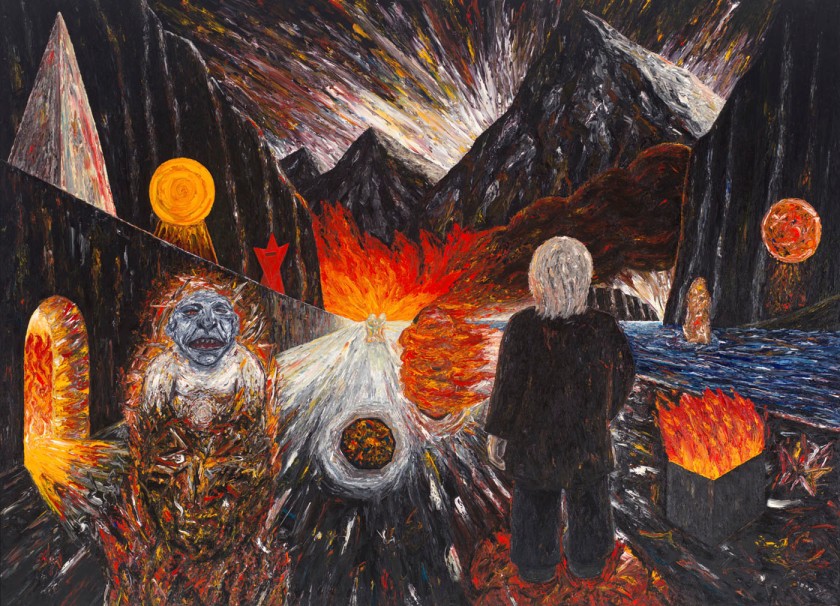

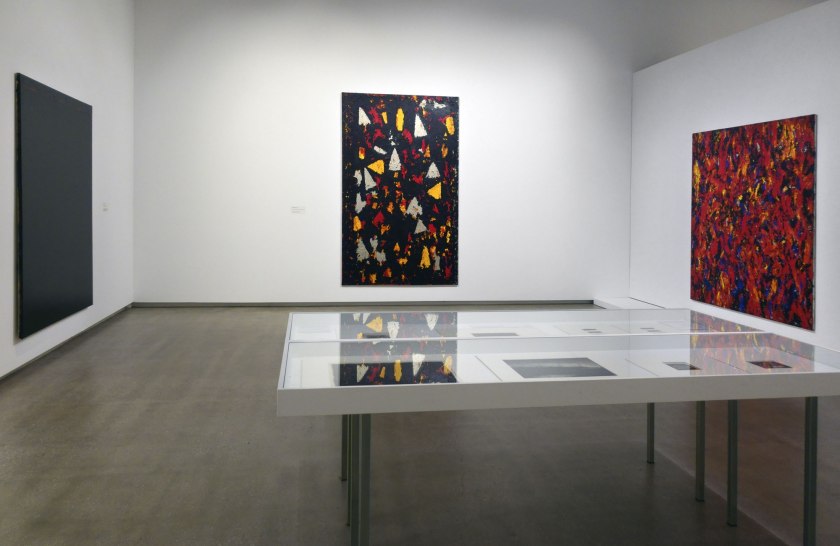

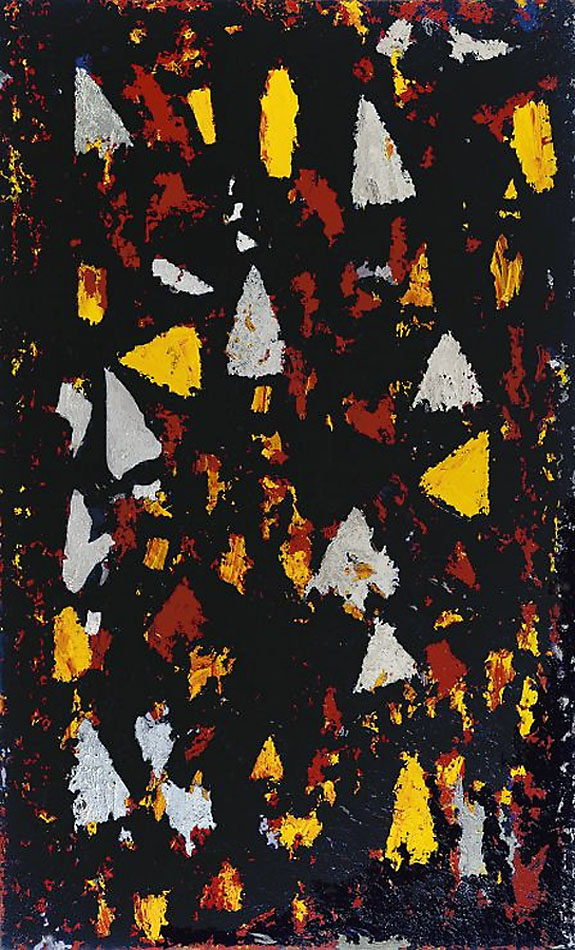
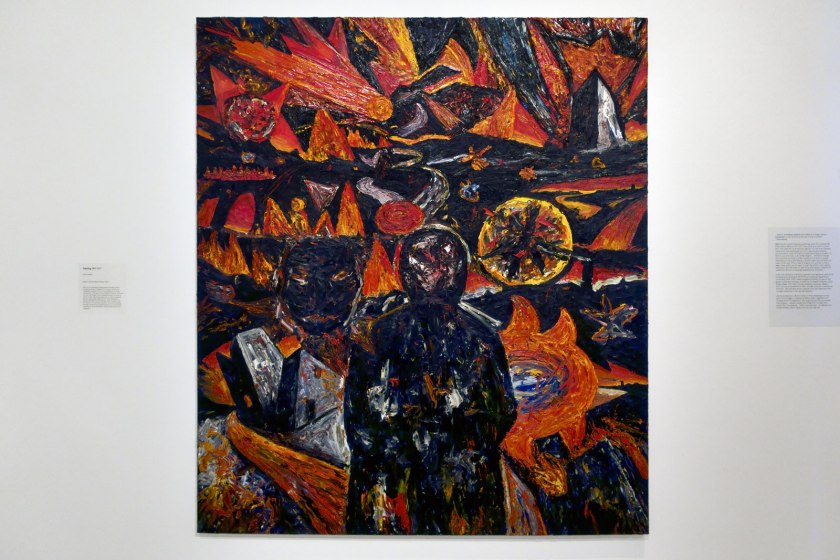




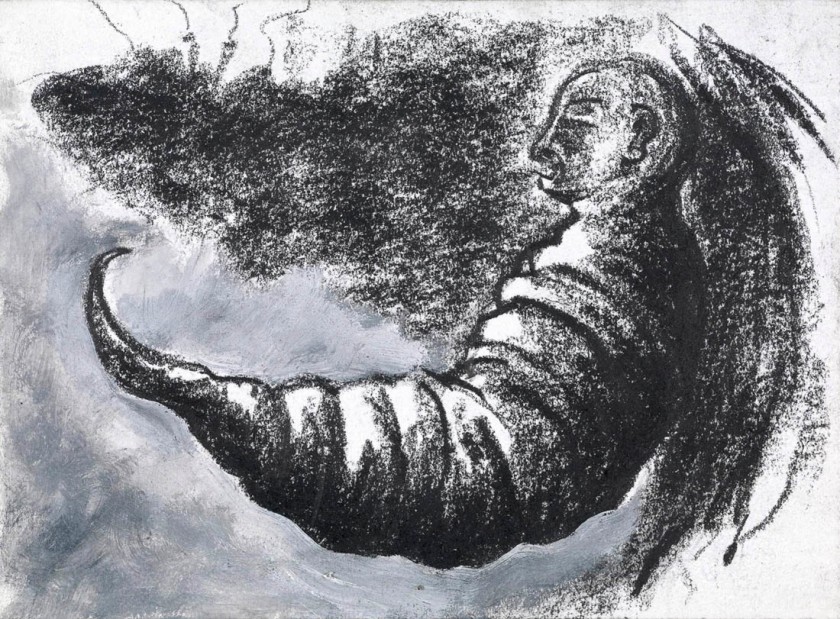



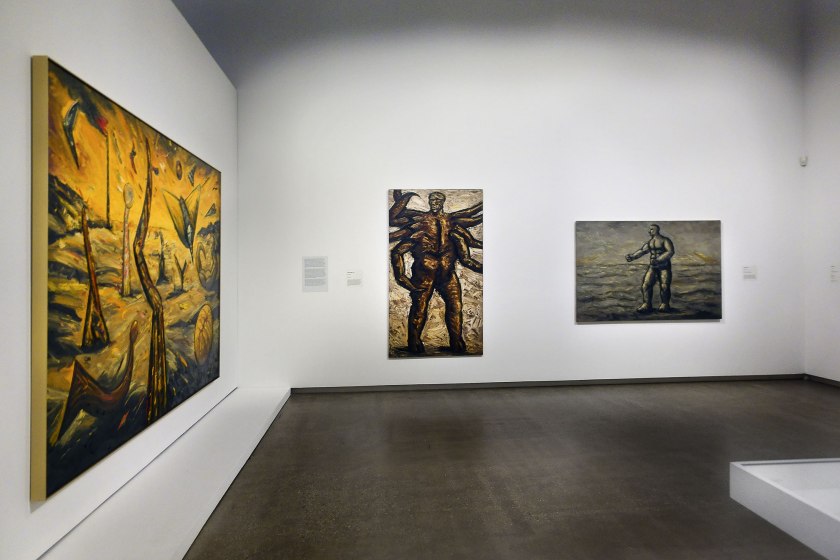
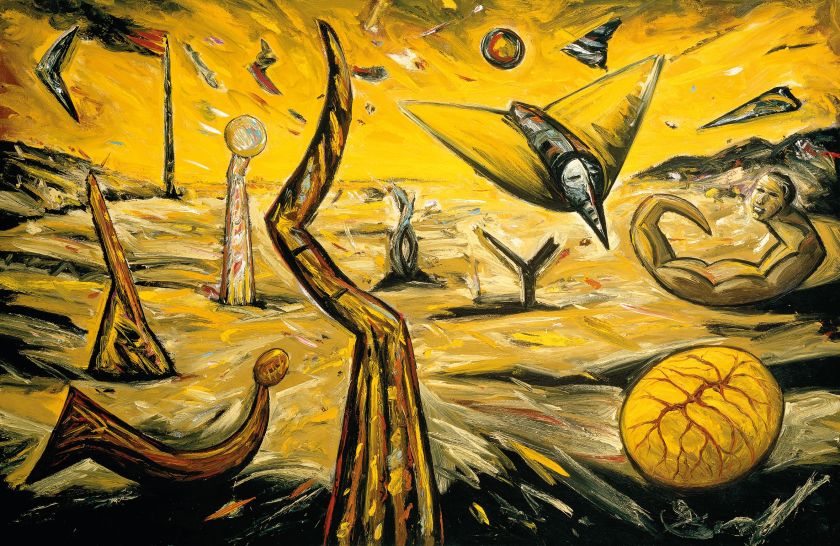

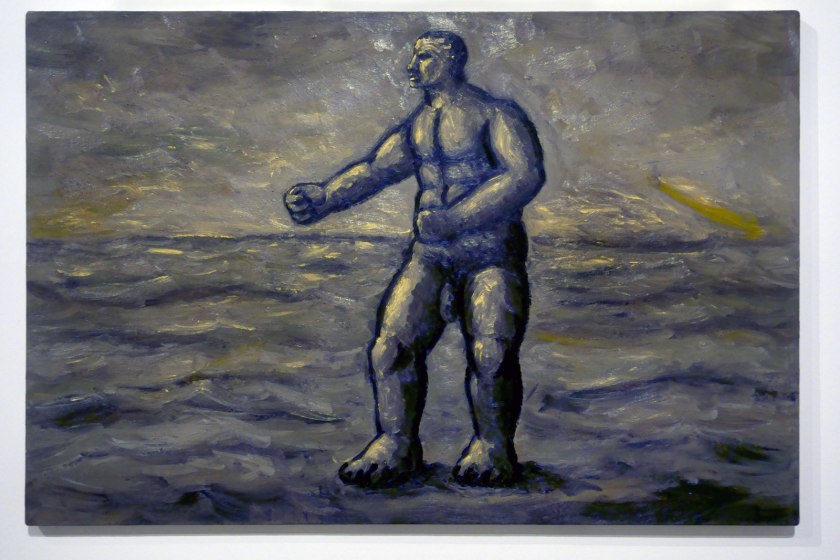
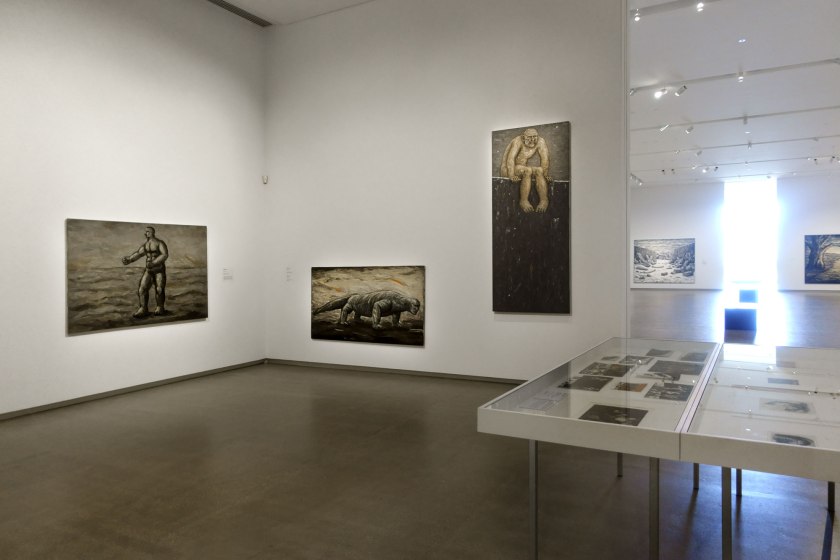
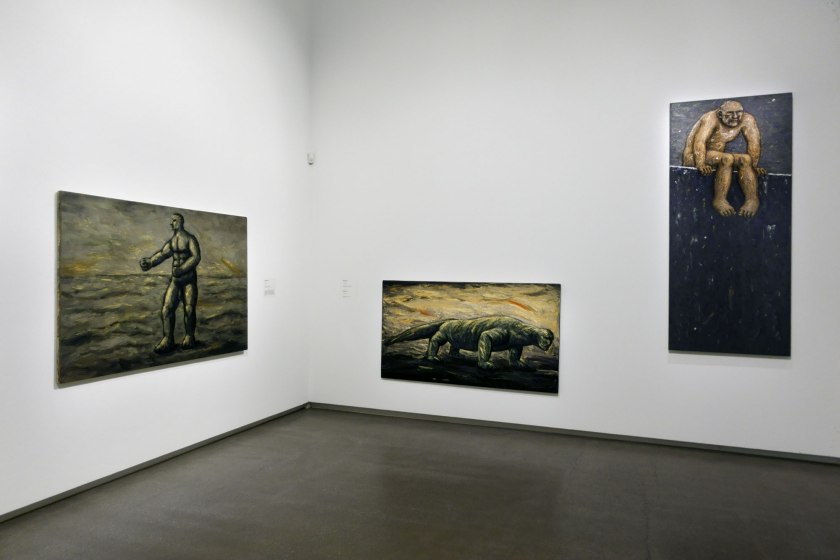
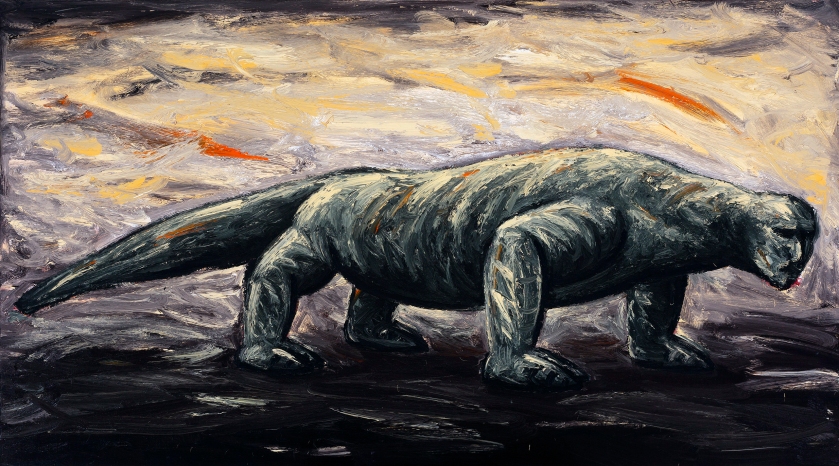

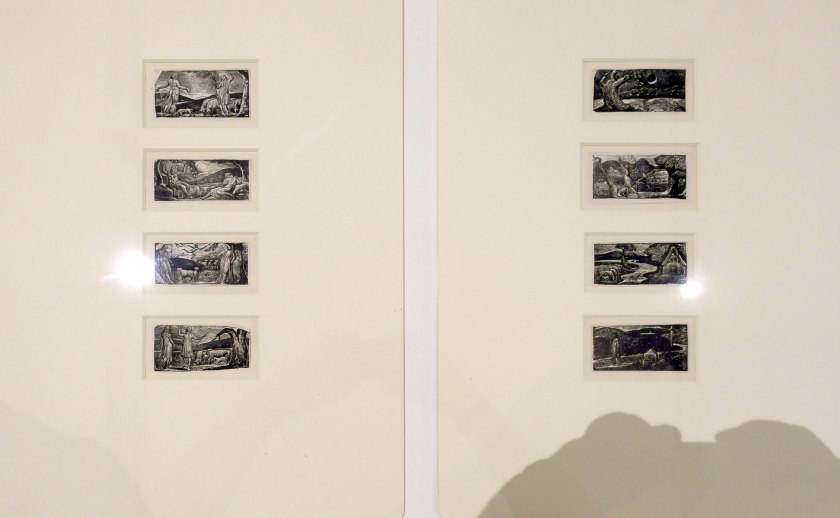


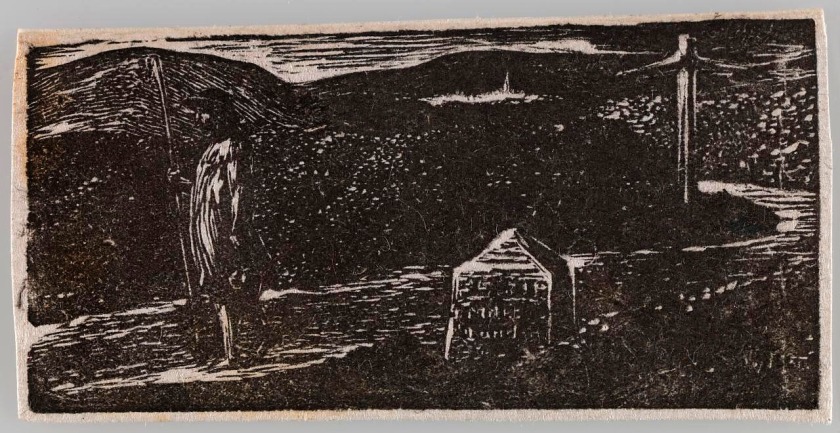


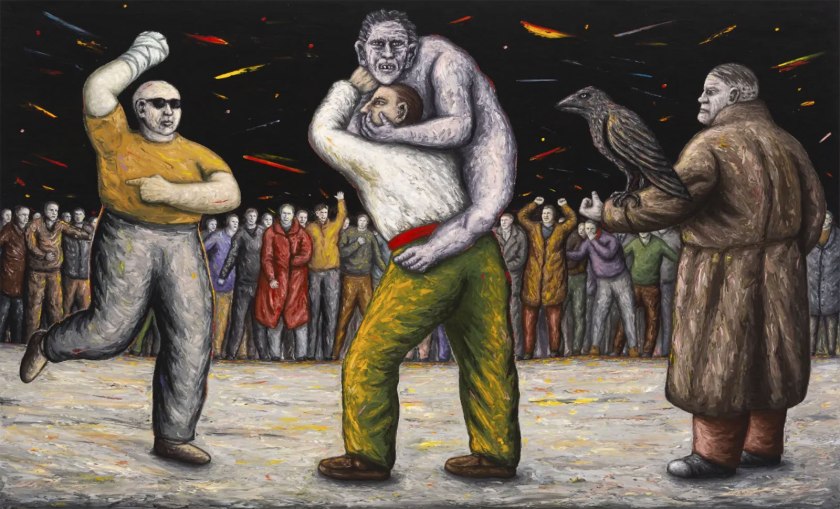

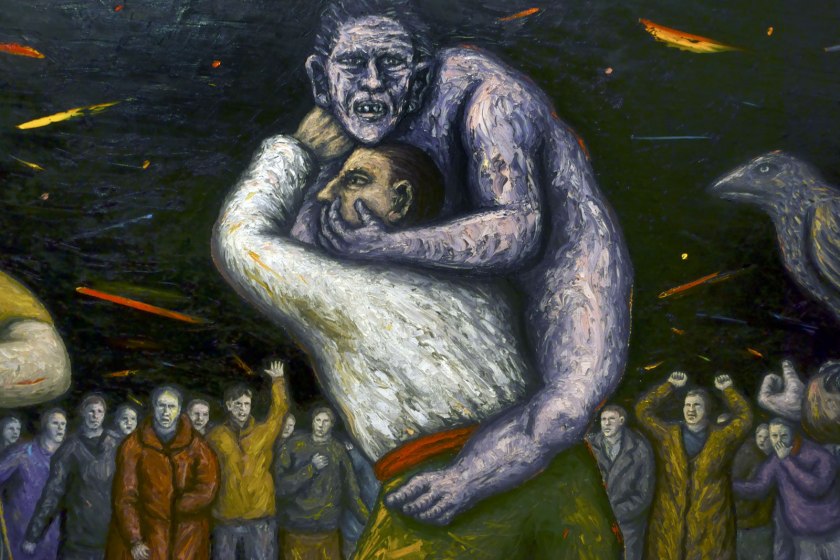
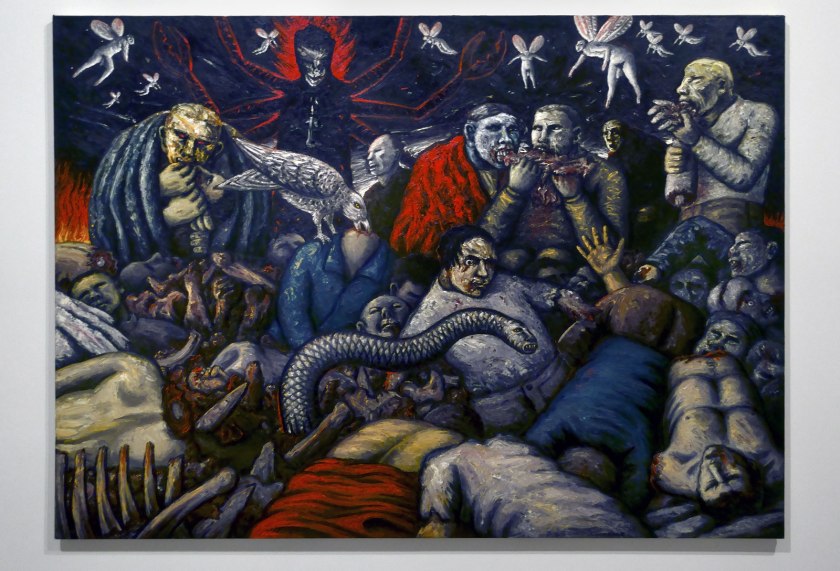



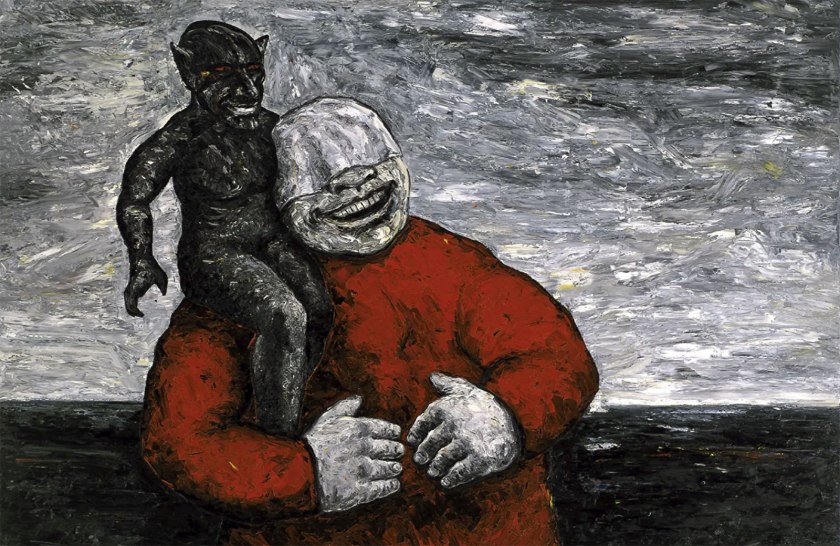
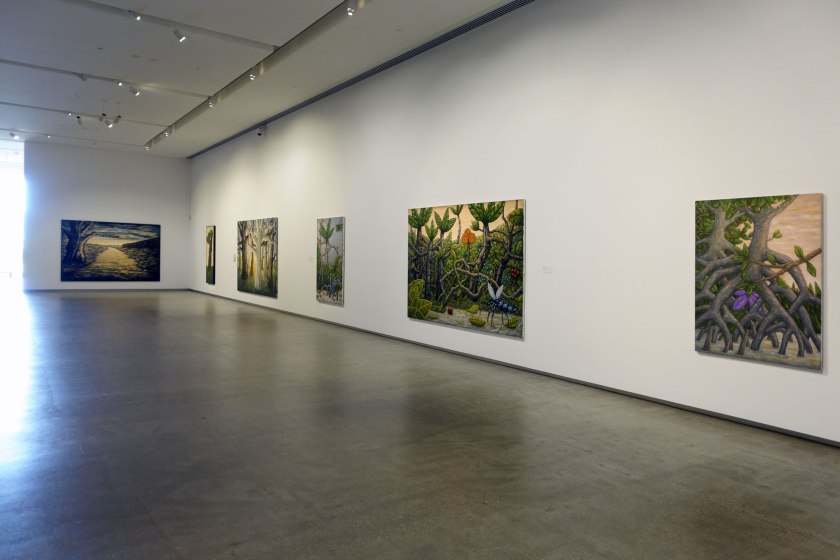

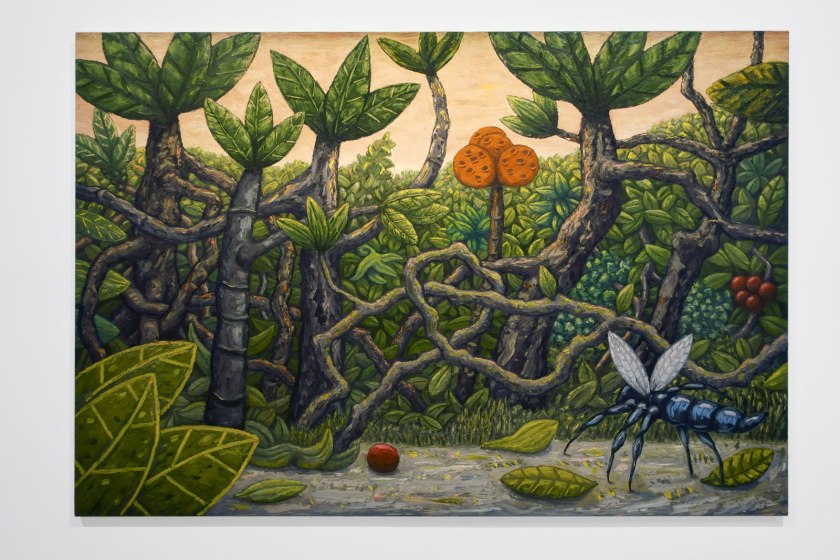
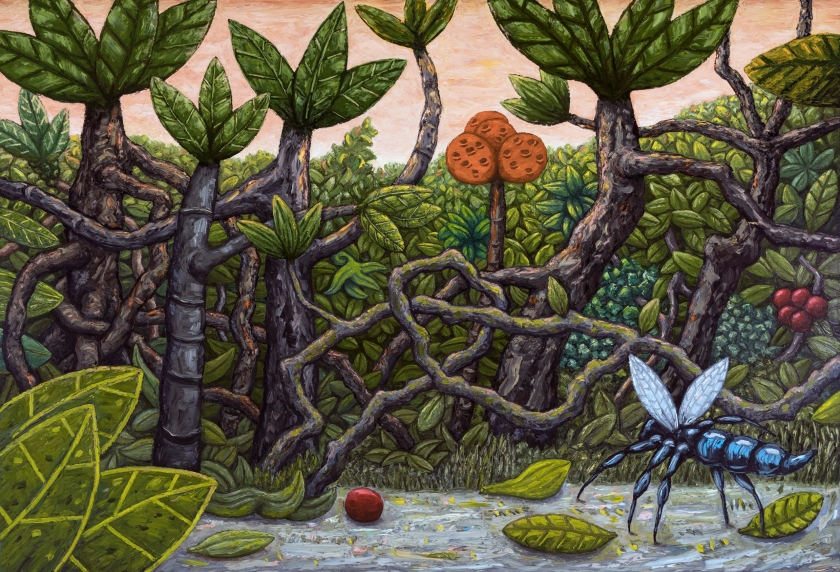
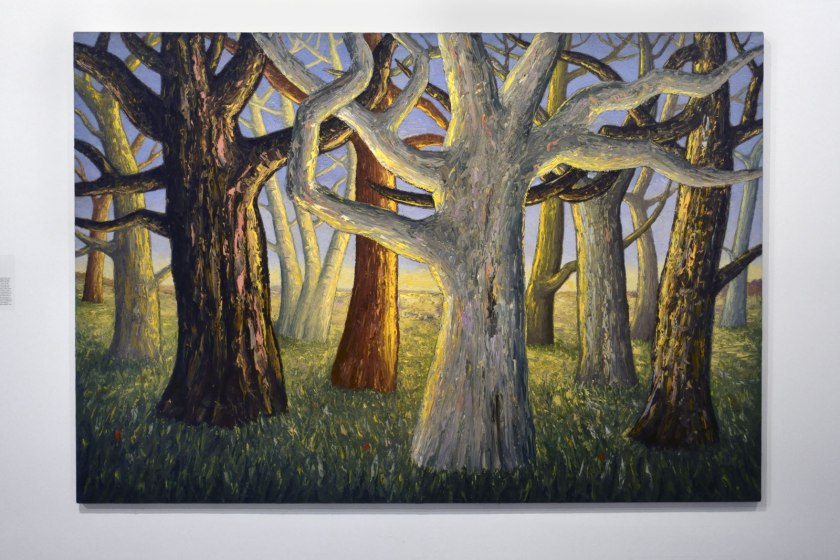
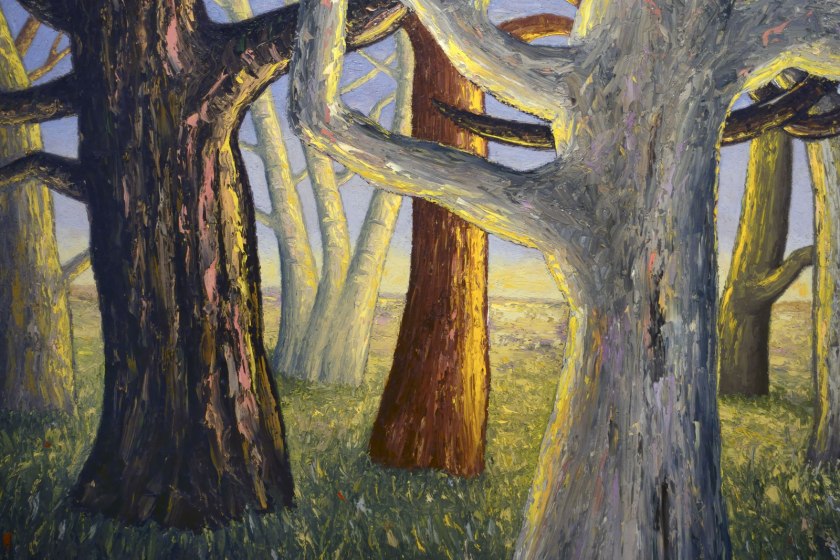
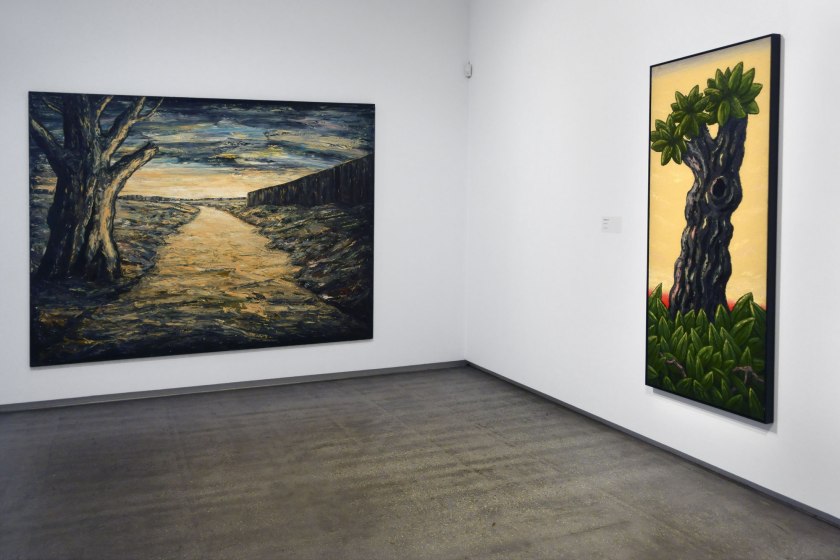
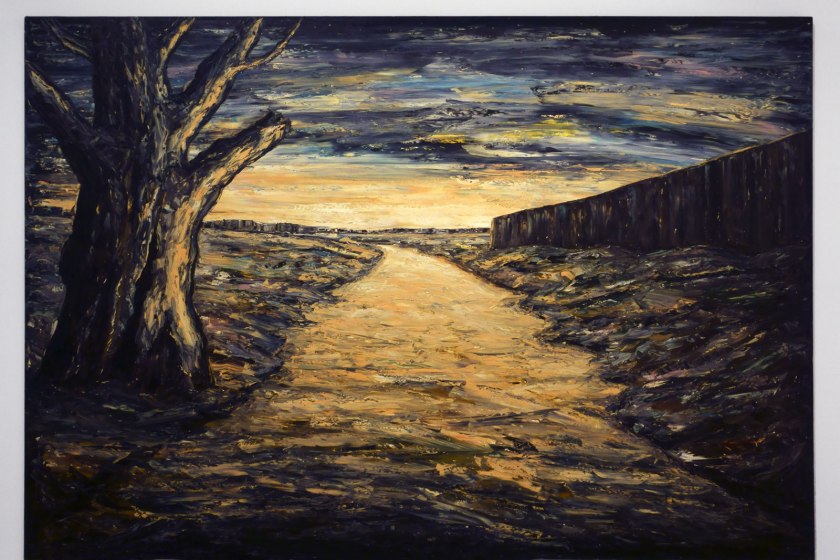


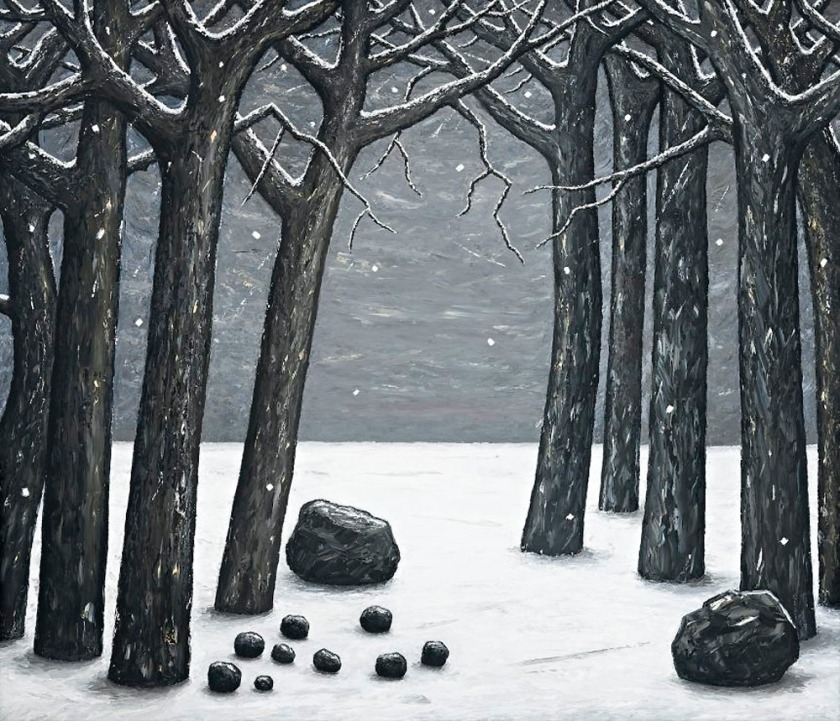
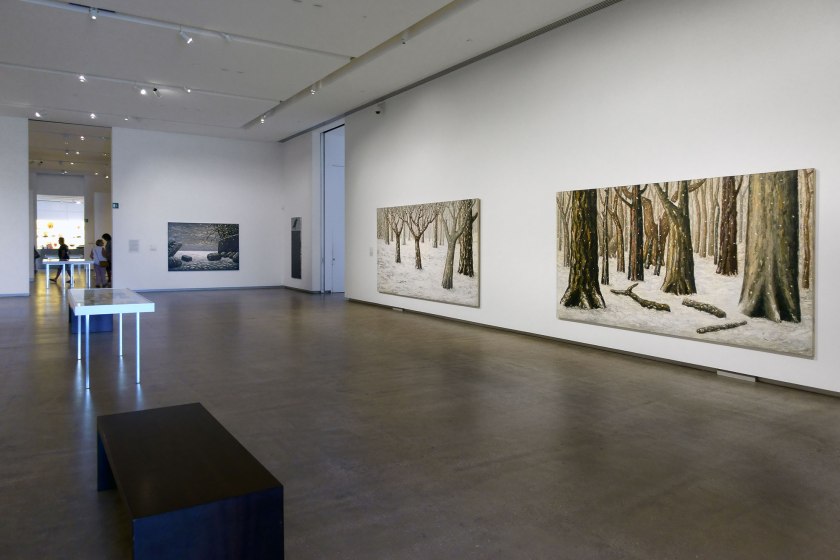



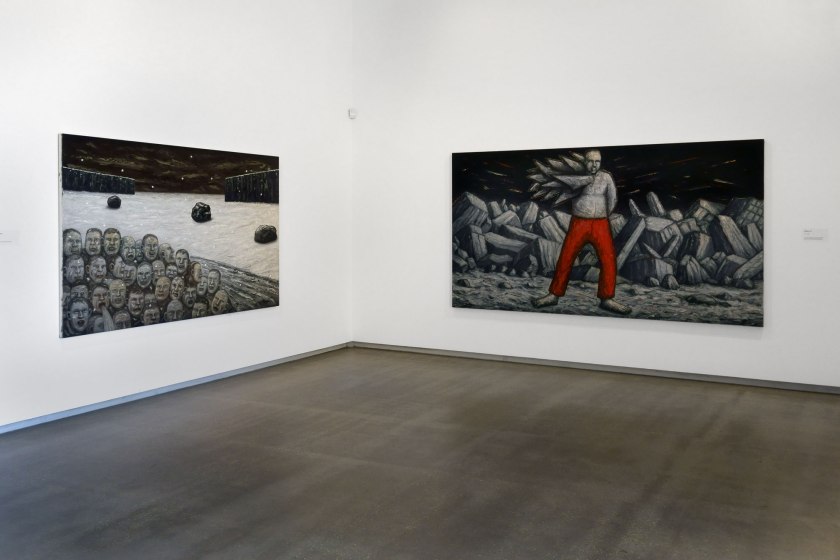
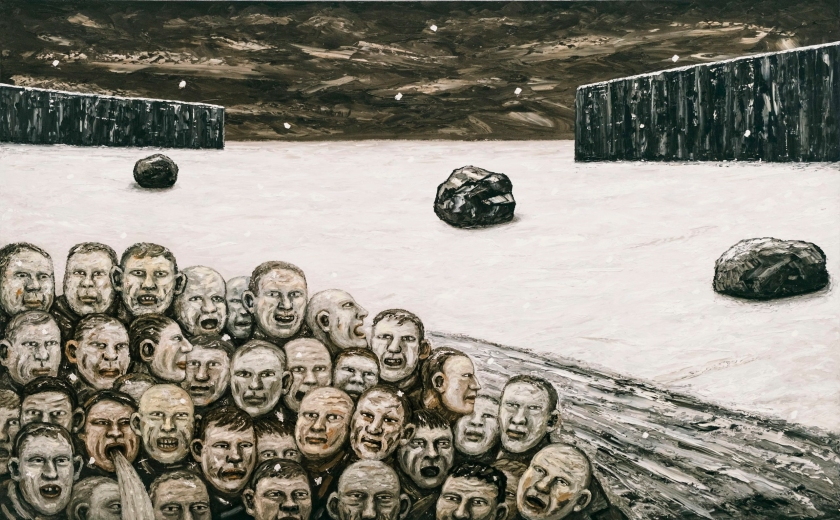
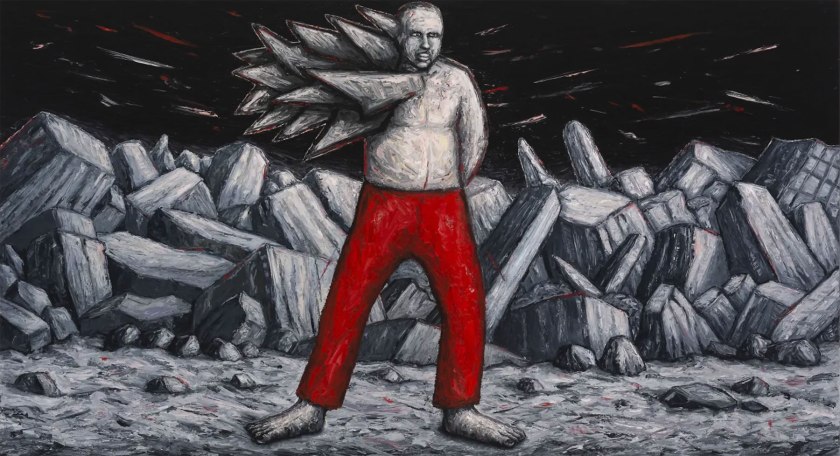
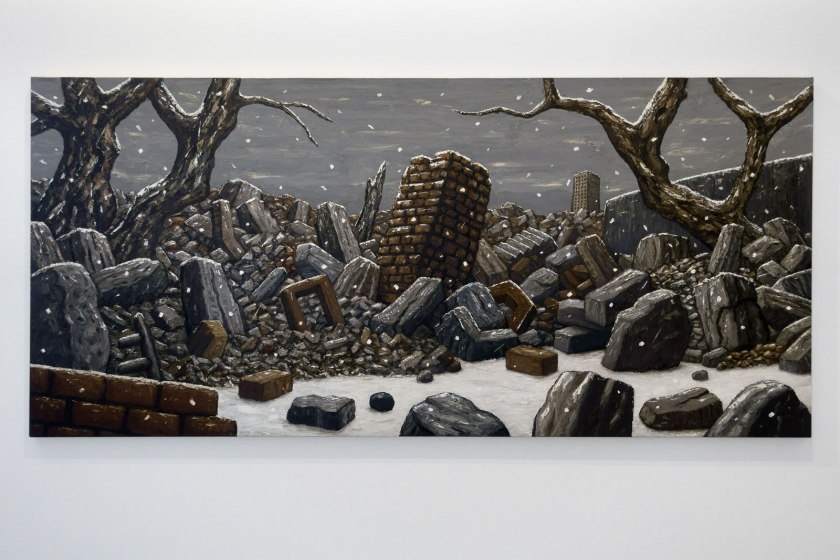
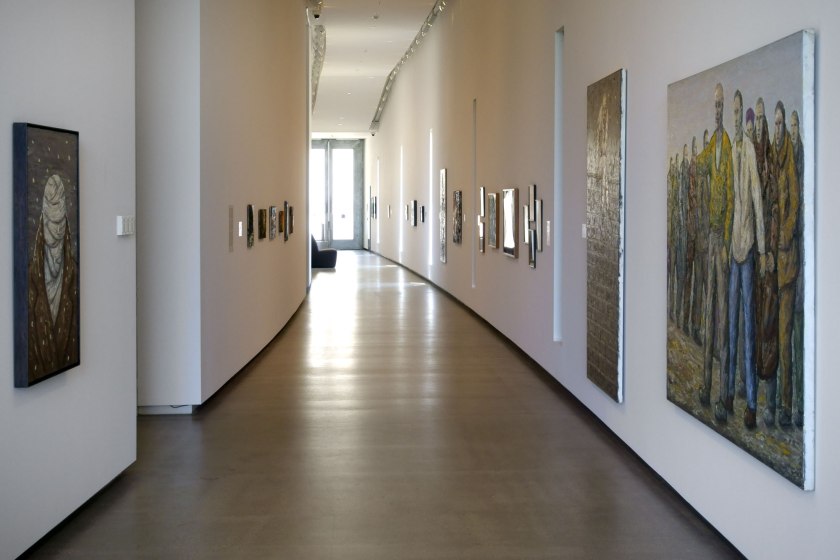

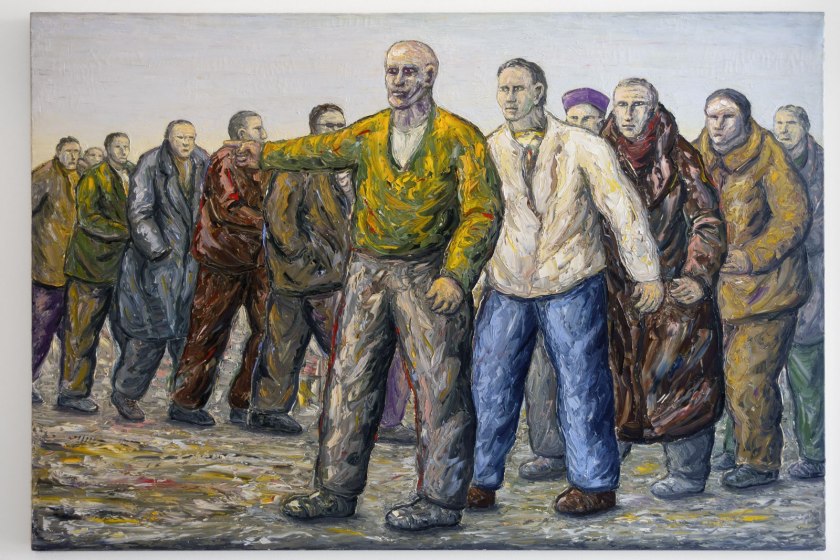
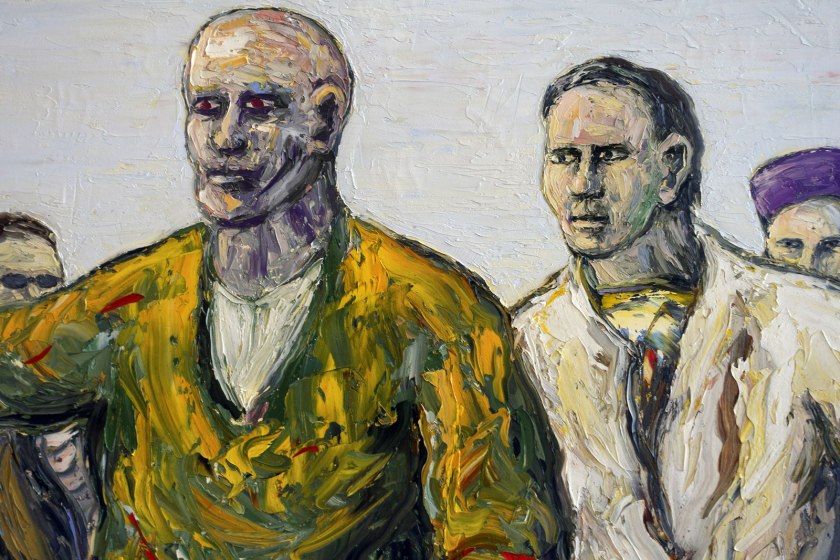



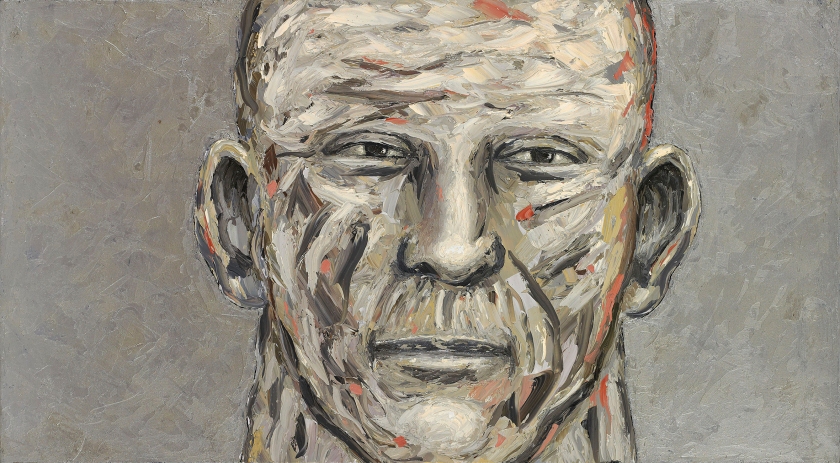
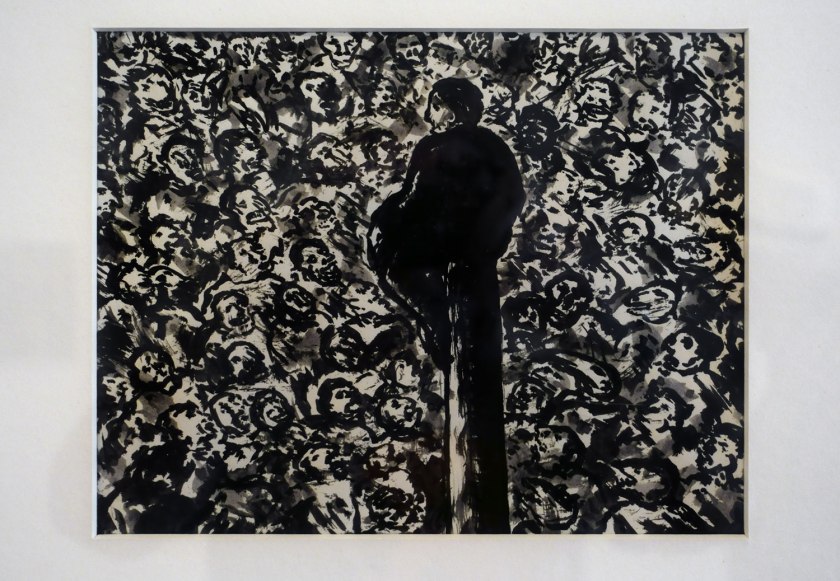
You must be logged in to post a comment.